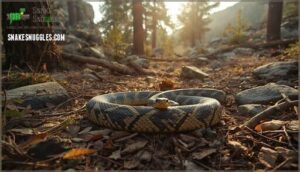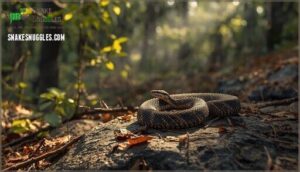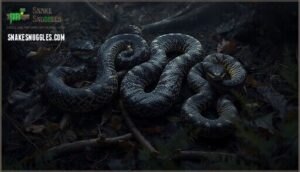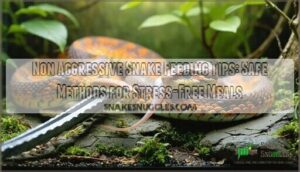This site is supported by our readers. We may earn a commission, at no cost to you, if you purchase through links.
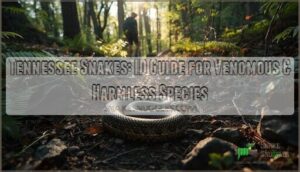 A hiker in the Smoky Mountains freezes mid-step as a thick, patterned snake coils near the trail. Is it a harmless ratsnake or a venomous copperhead? Tennessee is home to 32 snake species, but only four pose a real threat to humans. Most encounters end safely when you know what you’re looking at.
A hiker in the Smoky Mountains freezes mid-step as a thick, patterned snake coils near the trail. Is it a harmless ratsnake or a venomous copperhead? Tennessee is home to 32 snake species, but only four pose a real threat to humans. Most encounters end safely when you know what you’re looking at.
The challenge isn’t avoiding all snakes—it’s recognizing which ones demand respect and distance. Learning to identify Tennessee snakes by their body shape, scale patterns, and behavior helps you share outdoor spaces confidently.
This guide breaks down the key differences between venomous and harmless species so you can respond appropriately when you cross paths with these misunderstood reptiles.
Table Of Contents
- Key Takeaways
- Snake Identification Basics in Tennessee
- Venomous Snakes Found in Tennessee
- Common Non-Venomous Tennessee Snakes
- Snake Habitats and Behaviors in Tennessee
- Snake Safety and Coexistence Tips
- Frequently Asked Questions (FAQs)
- What is the most common snake in Tennessee?
- Does Tennessee have venomous snakes?
- What is the largest snake in Tennessee?
- Does TN have cottonmouth snakes?
- How can I safely remove a snake from my property?
- What should I do if I encounter a venomous snake?
- How can I protect my pets from snake encounters?
- Are there any snakes that are illegal to own in Tennessee?
- How can I report a snake sighting to authorities?
- What do baby snakes in Tennessee eat?
- Conclusion
Key Takeaways
- Tennessee hosts 32 snake species, but only four venomous pit vipers (Timber Rattlesnake, Pygmy Rattlesnake, Copperhead, and Cottonmouth) pose real danger, all identifiable by triangular heads, vertical pupils, heat-sensing pits, and keeled scales.
- Accurate identification relies on combining physical features like body shape and scale texture with behavioral cues and habitat context—copperheads freeze in leaf litter, cottonmouths display white mouth linings, and watersnakes flee rather than strike.
- Most snake encounters can be prevented through yard maintenance like removing debris, sealing foundation gaps, and controlling rodent populations, which reduces snake presence by up to 85%.
- If you spot a snake, stay calm and back away slowly to at least six feet—never attempt close identification or handling, and call 911 immediately for any bite since antivenom works best within hours.
Snake Identification Basics in Tennessee
Identifying snakes in Tennessee doesn’t have to feel overwhelming. You just need to know what to look for and how to put the clues together.
Let’s walk through the basics that’ll help you tell one species from another with confidence.
Key Features for Snake Identification
When you’re out on a trail, knowing what to look for can turn a confusing encounter into a confident identification. Here are five key snake characteristics that’ll help you identify species across Tennessee:
- Scale texture and arrangement – Smooth, glossy scales often signal nonvenomous snakes like kingsnakes, while rough, keeled scales with raised ridges generally mark venomous pit vipers.
- Head shape – A triangular or spade-shaped head suggests a venomous snake, whereas a rounded head points to most harmless species.
- Pupil shape – Elliptical, cat-like pupils indicate venomous snakes; round pupils mean you’re likely looking at a nonvenomous species.
- Body proportions and pattern mimicry – Length, build, and color patterns vary widely, and some harmless snakes mimic venomous ones to fool predators.
- Habitat and behavior – Where you spot the snake and how it acts narrows down your snake identification guide options fast. Venomous snakes often possess a distinctive sensory pit location between their eye and nostril, aiding in prey detection.
Distinguishing Venomous Vs. Non-Venomous Snakes
Once you’ve spotted the basics, the next step is separating harmless snakes from the four venomous pit vipers in Tennessee. All venomous snakes here share specific traits that set them apart from the 28 nonvenomous species.
| Feature | Venomous Snakes | Nonvenomous Snakes |
|---|---|---|
| Pupil Shape | Vertical, elliptical | Round |
| Head Shape | Triangular, arrow-shaped | Oval, rounded |
| Body Type | Thick, muscular | Slender, lithe |
Venomous snakes have heat-sensing pits between their nostrils and eyes—a dead giveaway you won’t find on harmless species. Habitat clues matter too: Cottonmouths stick to western water sources, while Copperheads roam statewide forests.
Tennessee boasts a variety of snake habitats from forests to wetlands. Behavioral traits help with snake identification—venomous pit vipers coil defensively and vibrate their tails, whereas nonvenomous snakes like watersnakes usually flee. Your snake identification guide becomes sharper when you combine these markers, reducing misidentification risks that lead to unnecessary alarm or harm.
Using Coloration, Patterns, and Length
Color variations and snake patterns are your most reliable field tools for rapid identification. Tennessee snake species show distinct markings that help you tell them apart quickly.
Here’s what to watch for:
- Pattern mimicry in banding – Copperheads display hourglass-shaped chestnut bands on tan bodies, while Scarletsnakes show red-black-yellow tri-color bands that mimic coral snakes (which aren’t found here).
- Length maturity as a clue – Gray Ratsnakes start near one foot as juveniles but stretch to six feet as adults, whereas Common Gartersnakes rarely exceed 26 inches.
- Geographic adaptation in coloration – Timber Rattlesnakes in eastern Tennessee appear darker than central populations, and Gray Ratsnakes in forested highlands look paler than swamp-edge individuals.
Snake camouflage shifts with habitat—Eastern Hog-nosed Snakes change dorsal patterns seasonally to match leaf litter.
Snake sizes combined with color help confirm species; a 72-inch black-to-tan gradient means you’ve found a Coachwhip.
Habitat Clues for Accurate Identification
Where you find a snake narrows down what you’re looking at. Tennessee has 32 native snake species across distinct ecoregions, and elevation indicators, moisture dependence, and vegetation clues shape which species you’ll encounter.
Rocky cedar glades host Eastern Kingsnakes, while riparian habitats shelter Common Watersnakes and Cottonmouths. Timber Rattlesnakes favor forested slopes up to 800 meters with southern exposure.
Urban habitats in Nashville and Knoxville show Black Racers and Ratsnakes in over 70% of suburban sightings. Geographic range and snake habitat details turn guesswork into confident snake identification.
Venomous Snakes Found in Tennessee
Tennessee has only one family of venomous snakes: pit vipers. All four venomous species in the state belong to this group and share certain traits like heat-sensing pits and vertical pupils.
Let’s look at each species so you can identify them in the field.
Timber Rattlesnake
The timber rattlesnake (Crotalus horridus) stands out as Tennessee’s largest venomous snake, reaching up to six feet in length. You’ll recognize it by its triangular head, heat-sensing pits between the eyes and nostrils, and distinctive chevron patterns on a gray or yellowish-brown body. The iconic rattle grows one keratin segment after each shed, though older segments often break off.
- Habitat Conservation: Lives in mature forests, rocky slopes, and south-facing hillsides; protected under Tennessee law as "in need of management"
- Venom Potency: Uses hemotoxins and neurotoxins to strike and track prey through heat-sensing pits
- Rattle Development: Adds keratin segments with each molt, creating the warning sound
- Mating Rituals: Breeds in late summer; females give live birth to 5–14 young every 2–4 years
- Ecological Impact: Eliminates up to 5,000 ticks annually by consuming rodent hosts
Pygmy Rattlesnake
Tennessee’s smallest pit viper, the Western Pygmy Rattlesnake (Sistrurus miliarius streckeri), measures just 15–20 inches but packs cytotoxic venom capable of causing significant tissue damage. You’ll spot this threatened species along the western Highland Rim, where habitat fragmentation threatens already scattered populations. Juveniles wiggle their yellow-tipped tails in caudal luring displays to attract frogs and lizards near wetland edges.
| Feature | Description | Identification Tip |
|---|---|---|
| Size variations | 15–20 inches (max 32 inches) | Smallest venomous snake in Tennessee |
| Rattle sound | Faint buzzing under 3 feet | Easily missed compared to timber rattlesnakes |
| Head markings | Black stripe eye to mouth | Nine large crown plates distinguish from larger rattlesnakes |
Conservation efforts by TWRA focus on protecting floodplain habitats in Stewart, Benton, Lawrence, and Hardeman counties, where you’re most likely to encounter this rare pit viper during late afternoon hunts near water sources.
Eastern Copperhead
This heavy-bodied pit viper (Agkistrodon contortrix) carries the distinctive copper-colored hourglass bands that make it Tennessee’s most frequently encountered venomous snake. You’ll find both Northern and Southern subspecies throughout the state, with hybrid zones where their ranges overlap in forested areas.
Copperhead venom causes localized tissue damage but rarely proves fatal. Juveniles use caudal luring—wiggling bright yellow tail tips—to attract frogs and lizards through ambush predation. Adults rely on freeze response behavior when threatened, which increases accidental snake bite risk during hikes.
Northern and Western Cottonmouths
These semi-aquatic pit vipers stick to Tennessee’s western third, especially around Reelfoot Lake’s swamps and wetlands. Western Cottonmouths appear nearly black with faint crossbands, while Northern Cottonmouths show clearer banding in olive-green to brown tones. Both subspecies flash white mouth linings when threatened—that’s where the name comes from.
Their cytotoxic venom destroys tissue at bite sites, though fatalities remain rare with antivenom. You’ll spot them basking near slow-moving water, where habitat conservation protects their "Least Concern" IUCN status despite wetland loss pressures.
Identifying and Comparing Venomous Species
All four venomous snakes in Tennessee share the telltale pit viper traits that set them apart from harmless look-alikes. Heat pits between nostrils and eyes detect warm-blooded prey, while triangular head shape houses venom glands. You’ll notice vertical pupils and keeled scale texture creating a rough appearance.
Here’s how venom potency ranks among Tennessee’s venomous snake species:
- Timber rattlesnake: Most potent hemotoxic venom causing severe tissue damage
- Cottonmouth: Cytotoxic venom destroying cells at bite sites
- Pygmy rattlesnake: Moderate venom but small yield
- Copperhead: Mildest venom with lowest fatality risk
Identifying venomous snakes becomes easier when you combine pupil shape, head contours, and distinctive patterns like the copperhead’s hourglass bands.
Common Non-Venomous Tennessee Snakes
Most snakes you’ll encounter in Tennessee won’t harm you. The state’s home to more non-venomous species than venomous ones, and learning to recognize them can ease your worries on the trail.
Let’s look at six common harmless snakes you’re likely to see.
Gray Ratsnake
You’ll spot the Gray Ratsnake climbing trees, barns, and structures across Tennessee—this nonvenomous snake species excels at rodent control around farms and homes.
Adults reach 42 to 72 inches with dark gray coloration, while juveniles display prominent blotches that fade with age. When threatened, they use defensive mimicry by vibrating their tails like rattlesnakes.
Their climbing ability and habitat connectivity make them essential in forest, woodland, and suburban environments throughout the state.
Common Watersnake
You’ll find the Common Watersnake near rivers, ponds, and marshes statewide—this nonvenomous snake species often gets mistaken for venomous cottonmouths.
Adults measure 24 to 42 inches with grayish-brown coloration and dark crossbands that fade toward the tail. Their keeled scales, heavy build, and defensive strikes protect them, though they’re harmless.
Aquatic adaptations let them stay submerged up to 90 minutes, hunting fish and amphibians along shorelines.
Black Kingsnake
While watersnakes stick to aquatic habitats, Black Kingsnakes roam forests, farmlands, and wetlands across Tennessee. These nonvenomous snakes measure 36 to 45 inches with smooth jet-black scales and creamy bellies. Their snake immunity lets them hunt copperheads and rattlesnakes without harm—an ophiophagy behavior that aids habitat preservation. You’ll recognize kingsnakes by their stocky build and checkered belly pattern.
Conservation status remains stable statewide, though road mortality threatens local populations. Their kingsnake diet includes rodents and venomous snakes in Tennessee, making them valuable allies for snake identification enthusiasts.
Common Garter Snake
You’ll spot Common Garter Snakes in Tennessee more often than kingsnakes—they’re statewide visitors to yards and gardens with three yellow or white stripes running down their 18- to 26-inch bodies.
Garter habitat includes wetlands, fields, and suburban areas where their garter snake diet of frogs, earthworms, and rodents aids wildlife management.
These nonvenomous garter snakes help with snake conservation through natural pest control, making reptile research and snake identification straightforward for Tennessee snake enthusiasts.
Ring-necked Snake
Ring-necked snakes are small nocturnal species that won’t exceed fifteen inches in Tennessee. You can identify these nonvenomous snakes by their slate-gray backs and distinctive yellow collar, plus bright belly coloration.
Ring-necked habitat includes moist woodlands statewide, where ringnecked snake populations thrive under logs and leaf litter. Their ring-necked behavior includes defensive coiling to expose colorful undersides.
Snake identification shows species adaptation through mild venom that only affects earthworms and slugs—snake conservation benefits from recognizing these harmless Tennessee snakes.
Hognose and Other Harmless Species
Eastern Hognose Snakes showcase striking hognose adaptations with upturned snouts for burrowing and dramatic bluff strikes that never break skin. You’ll identify these harmless, nonvenomous species—essential for ecological balance—by their stout bodies (20–33 inches), variable patterns, and theatrical death-feigning displays.
Tennessee’s snake species rely on snake identification through behavior: hognose snakes flatten their necks cobra-style but exist solely for wildlife preservation and snake conservation through amphibian control.
Snake Habitats and Behaviors in Tennessee
Understanding where Tennessee snakes live and how they act helps you identify them in the wild. Different species choose different habitats, hunt at different times, and use unique strategies to survive.
Let’s look at the key behaviors and environments that define Tennessee’s snake populations.
Forest, Woodland, and Aquatic Habitats
Tennessee snakes rely on three main habitat types: forests, woodlands, and aquatic ecosystems. Forest ecology sustains roughly 45% of the state’s snake species, including Gray Ratsnakes and Timber Rattlesnakes, which use rocky ledges and canopy cover for thermoregulation.
Woodland biodiversity peaks at edge zones where prey is abundant.
Aquatic habitats shelter nearly 30% of Tennessee snakes, like watersnakes and cottonmouths. Habitat fragmentation and ecological conservation efforts directly impact venomous snakes and their survival across these environments.
Activity Patterns: Nocturnal Vs. Diurnal
Most snake species in Tennessee shift their activity patterns based on temperature effects and diel cycles. Diurnal species like Eastern King Snakes and Garter Snakes bask during cooler months, while nocturnal hunting becomes common in summer heat. Timber Rattlesnakes switch to nighttime activity when temperatures climb, and circadian rhythms guide these behavioral changes.
Snake migration to brumation sites begins in October across Middle Tennessee snake habitats.
Diet and Hunting Strategies
You might be surprised how adaptable snakes are regarding what they eat. Tennessee snakes have diverse diets shaped by where they live and what prey is available.
- Gray Ratsnakes hunt mice, rats, and squirrels in barns and woodlands, acting as natural rodent control
- Garter Snakes prefer frogs, toads, and earthworms near streams and wetlands
- Kingsnakes eat other snakes—even venomous ones—plus small mammals and birds
- Young copperheads wiggle their bright yellow tails to lure curious frogs within striking distance
Constrictors like Ratsnakes squeeze prey until it stops breathing, while venomous species inject toxins that break down tissue before swallowing.
Defensive Behaviors and Camouflage
When a snake feels cornered, it relies on clever tricks rather than aggression. Defensive tactics blend visual deception with behavior—copperheads stay perfectly still among leaf litter, reducing predator detection by about 35%. Cottonmouths open their white mouths wide in a threatening display called "gaping," while hognose snakes flatten their necks and play dead if the bluff fails. Mimicry strategies help harmless kingsnakes survive by resembling venomous species through dark coloration.
Adaptive coloration works best when snakes combine stillness with pattern—remaining motionless for 10 seconds boosts survival dramatically.
| Defense Type | Example Species |
|---|---|
| Camouflage | Copperhead, watersnake |
| Bluff displays | Hognose, cottonmouth |
| Mimicry | Black kingsnake |
| Tail lures | Juvenile copperhead |
| Rattling | Timber rattlesnake |
Snake Safety and Coexistence Tips
Knowing how to share space with Tennessee’s snakes keeps both you and them safe. A few simple habits can prevent most encounters, and knowing what to do when you spot a snake makes all the difference.
Here’s what you need to remember about staying safe in snake country.
Preventing Encounters in Snake Habitats
A well-maintained yard is your first line of defense against unwanted wildlife encounters. Yard Maintenance and Habitat Modification work hand-in-hand to reduce snake habitats in Tennessee and improve snake safety around your home.
- Mow lawns regularly and trim vegetation within 1–2 inches of structures to eliminate sheltering spots.
- Remove debris like woodpiles, tall grass, and rock piles, which can lower snake habitat suitability by over 70%.
- Maintain a 20-foot buffer zone between woodpiles or compost heaps and your home to decrease sightings.
- Control rodent populations by storing pet food and birdseed in sealed containers—cutting snake presence by up to 85%.
- Seal foundation gaps and cracks as small as 0.25 inches using caulk or hardware cloth for effective snake proofing.
These Environmental Design strategies and wildlife control measures help you coexist peacefully with venomous snakes in Tennessee while protecting your family and pets.
What to Do if You See a Snake
Even the best prevention won’t stop every wildlife encounter, so knowing how to respond can prevent venomous bites and keep everyone safe. When you spot a snake, stay calm and freeze in place—sudden movements trigger defensive strikes in Copperheads and Timber Rattlesnakes.
Back away slowly, giving the snake at least six feet of space for emergency response and natural retreat. Don’t attempt snake identification up close or handle it yourself; instead, contact TWRA or a licensed professional for safe snake removal if it’s near your home.
First Aid for Snake Bites
If bitten, your first move is staying calm and calling 911 immediately—antivenom administration works best within hours of the bite. Keep the affected limb still and at heart level while removing jewelry before swelling starts.
Wash the wound with soap and water, then cover it with a clean cloth.
Don’t cut the bite, apply ice, or try capturing the snake—these actions worsen tissue damage and delay emergency response, which remains your best shot at full recovery from venomous snake species.
When to Seek Professional Help
Beyond first aid, you’ll need professional assistance when snakes appear repeatedly on your property or when you can’t identify a species safely. Wildlife control services handle venomous snakes under TWRA permits, ensuring legal compliance and preventing the 40% misidentification rate between harmless watersnakes and cottonmouths.
Contact professionals when you notice:
- Multiple snake sightings within days, suggesting nearby nesting sites in wood piles or crawl spaces
- Shed skins or droppings near foundations, indicating established movement patterns along scent trails
- Rodent problems attracting snakes—infestations increase snake presence by 60%
- Snakes entering through gaps smaller than half an inch in vents or exterior walls
- Continued activity after DIY repellents fail—70% of homeowners face recurrence within two months using store-bought products alone
Emergency response becomes critical for venomous bites requiring antivenom, which costs $10,000–$20,000 per treatment but saves lives when administered quickly.
Frequently Asked Questions (FAQs)
What is the most common snake in Tennessee?
The Common Garter Snake stands out as Tennessee’s most frequently encountered snake species.
You’ll find this nonvenomous snake across diverse habitats statewide, from wetlands to gardens, making it a regular presence in both wild and developed areas.
Does Tennessee have venomous snakes?
You might spot a rattlesnake on a trail hike or notice a copperhead near your woodpile.
Tennessee has four venomous snake species: Timber Rattlesnake, Pygmy Rattlesnake, Copperhead, and Cottonmouth.
Identifying venomous snakes in Tennessee helps prevent snakebites and ensures your safety outdoors.
What is the largest snake in Tennessee?
The Timber Rattlesnake holds Tennessee’s snake size records as the largest venomous snake species, reaching up to 7 feet.
Most adults measure 36 to 60 inches, but rare individuals exceed these typical snake lengths.
Does TN have cottonmouth snakes?
Yes, cottonmouth snakes inhabit Tennessee, primarily in western regions near aquatic habitats like swamps and slow-moving streams. Northern Cottonmouth populations thrive around places like Reelfoot Lake, where venomous behavior and regional ecology intersect with snake conservation efforts focused on these semi-aquatic pit vipers.
How can I safely remove a snake from my property?
If you can identify the snake as non-venomous, place a trash can over it and slide something flat underneath to relocate it safely.
For venomous species or uncertain identifications, contact professional snake removal services immediately to guarantee safe handling and property modifications.
What should I do if I encounter a venomous snake?
If you spot a venomous snake, stay calm and back away slowly to give it space. Don’t handle or provoke it.
Keep a safe distance and let the snake escape on its own.
How can I protect my pets from snake encounters?
Keep your pets leashed in snake habitats and stick to clear trails. Remove yard debris and tall grass to reduce snake hiding spots—this can cut snake activity by up to 50%.
Consider snake avoidance training for dogs and ask your vet about rattlesnake vaccines if you live near venomous snakes in Tennessee.
Always seek immediate veterinary care if your pet is bitten.
Are there any snakes that are illegal to own in Tennessee?
Tennessee law protects all native snake species, making it illegal to own venomous snakes like copperheads or rattlesnakes without permits from TWRA.
Exotic snake laws also restrict Class I venomous species. You can’t collect or possess protected species without proper wildlife regulations and snake permits in place.
How can I report a snake sighting to authorities?
You won’t believe how easy it’s—just snap a photo and contact the Tennessee Wildlife Resources Agency (TWRA) through their regional offices or online sighting forms.
Include GPS coordinates, snake identification details, and coloration to support conservation efforts and public safety guidelines.
What do baby snakes in Tennessee eat?
Baby snakes in Tennessee have diverse diets depending on snake species and venomous or non-venomous classification. Neonate prey includes small invertebrates like worms, insects, tadpoles, and pinky mice.
Prey size usually stays under two inches, matching their hunting tactics. Snake behavior shifts to available food sources in different habitats.
Conclusion
Think of identifying Tennessee snakes like learning a new language—each pattern, scale, and behavior tells a story that keeps you safe. You don’t need to memorize every detail about all 32 Tennessee snakes, just the handful of features that separate the venomous from the harmless.
Next time you spot a serpent on the trail, you’ll read those clues with confidence instead of panic. That shift from fear to understanding transforms every hike into a chance to appreciate these misunderstood reptiles.
- https://worldpopulationreview.com/state-rankings/snake-population-by-state
- https://outforia.com/snakes-in-tennessee/
- https://www.tn.gov/twra/wildlife/reptiles/snakes.html
- https://www.herpconbio.org/Volume_20/Issue_1/Strebler_etal_2025.pdf
- https://digital.tnconservationist.org/article/Snake+Safety+in+Tennessee/4964970/844789/article.html

